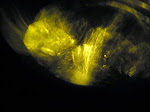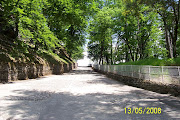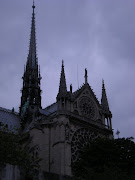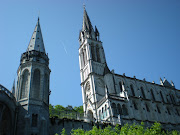picture by hendra boeniardi
In 1670, Louis XIV - the Sun King - founded Les Invalides near what was then called the Grenelle Plain. An old soldiers home, it was funded by a five year levy on the salaries of soldiers currently serving in the army at that time. The first stones were laid in 1671, for what was to become a complex providing quarters for 4,000. Construction followed plans drawn up by Libéral Bruant, and was completed in 1676. The Esplandade was layed out by Robert de Cotte.
Construction of the dome began in 1706. Designed by Jules Hardouin-Mansart and completed by de Cotte after Mansart died in 1708. Many of the arms used by the mob when it attacked the Bastille on 14 July 1789 were taken from Les Invalide on the morning of that day. Despite resistence by the posted sentries, they were overwhelmed by the mob which finally entered the underground rifle storehouse. Roughly 28,000 arms were taken. of the dome began in 1706. Designed by Jules Hardouin-Mansart and completed by de Cotte after Mansart died in 1708. Many of the arms used by the mob when it attacked the Bastille on 14 July 1789 were taken from Les Invalide on the morning of that day. Despite resistence by the posted sentries, they were overwhelmed by the mob which finally entered the underground rifle storehouse. Roughly 28,000 arms were taken.
The most significant event in the history of Les Invalides however, is unquestionably the return of the body of Napoléon in 1840. After seven years of negotiation with the British government, Louis-Philippe, King of France, obtained permission to repatriate the Emperor's remains from St. Helena. On 8 October 1840 - 19 years after the death of the Emperor - the coffin was exhumed and opened for two minutes before transport to France aboard the frigate La Belle Poule. Those present claim that the body remained in a state of perfect preservation.
After arriving at Le Havre, it was brought up the Seine and landed at Paris at Courbevoie. On 15 December 1840 a state funeral was held, and despite a winter snowstorm, the hearse proceeded from the Arc de Triomphe down the Champs-Elysées, across the Place de la Concorde to the Esplanade and finally to the cupola in St Jerome's Chapel until the tomb - designed by Visconti - was completed. On 3 April 1861 Napoléon I came to his final rest in the crypt under de dome.(PARIS.ORG)

HENDRA TANOEMIHARDJA"S area of contemplation
To write down everything just owned by human to aware our existence, transcendent our thought and therefore to differentiate us with another creatures, included creatures as angels and demons. And our Father made us inferior only to Himself.
AREA OF CONTEMPLATION WITH AWARENESS THAT GOD ALWAYS LOVE AND NEVER ABANDON US.
Lorem ipsum dolor sit dicatum animum explorant plena dilectione Dei notitia , et non derelinquas nos semper.
Tuesday, November 25, 2008
DES INVALIDES , MUSEE DE L'ARMEE PARIS , MUSSOLEUM BONAPARTE
Labels:
Bastille,
French Revolution,
history,
museum
Subscribe to:
Post Comments (Atom)
MAP I HAD BEEN THERE
MARY IMMACULATE, SHINING THE BEAUTY

Immaculada de Concepsiou - Pray with Mary for our sins . Ask God give mercy ang grace. Always honoured and praised every where
LITTLE HOUSE ON THE VALLEY , ARAULEN BOTANICAL GARDEN , WA

In summer the flowers , in the silence joyful and happiness
A SERENITY AND SANCTUARY

Invite to pray and contemplation
A PURE SPRING WATER INSIDE GROTTO

Has continued to flow since 1858 ; he that believeth on Me , out of his belly shall flow rivers of living water
POPE BEFORE THE GROTTO

Pray with Mary when Jubileum Year 150 years
THE MOTHER OF GOD

By her apparitions as Our Lady of Guadalupe to Saint Juan Diego
ALL OF THE SAINTS

When two holly people met
VIA DOLOROSA AT SANCTUARIES LPORDES

A lonesome road visited by million of pilgrims
FROM GABATHA TO GOLGOTHA

Jesu , Joy of man's desiring . Commemoration of Holy Friday in my parish "You are my disciples, if you keep obeying my teachings"
Mary Magdalene

By Gestilenchi
NOTRE DAME BASILICA - PARIS

Mother of Church Diocese of Paris
LIFE IS EXCITING AND CHALLENGING

Filled it with wonder
NOTRE DAME BASILICA - PARIS

Pictured from Seine river, started build in 11th century , Pope Alexander III laid the first stone
TIME IS ETERNITY

BASILIQUE IMMACULADE DE CONCEPCIOU - SANCTUARIES LOURDES

Built as Lady Mary's request to Bernarde
BERNADETTE SOUBIROUS 1844 - 1879 , 18 apparitions of a Lady , Mary

Canonised in 1933 , a miracle : her body incorruptible after death
MARY AT GROTTO WHERE MOTHER OF GOD MET BERNADETTE SOUBIROS in 1858

Eucharist celebration with Sacrament adoration continuously along the day for the glory of God.
CANDLE PROSESSION IN THE FRONT OF BASILIQUE NOTRE DAME SANCTUARY LOURDES
.jpg)
A very amazing and an undescribed feeling and emotion . Hail Mary for the glory of God
BLESSING - MAY OUR GOD GIVE BLESSING

And ye will not come to me, that ye might have life.


No comments:
Post a Comment